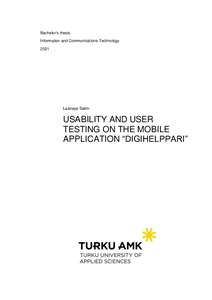

All rights reserved. This publication is copyrighted. You may download, display and print it for Your own personal use. Commercial use is prohibited.
Julkaisun pysyvä osoite on
https://urn.fi/URN:NBN:fi:amk-2021053112944
The importance of application testing along with the consequences that defects have on the final product has played a huge role in the development process. With the constant increase of mobile applications in today's large market, it has become an important process to ensure software quality. Thus, companies have taken the initiative to increase their attention to detail, leaning more on different application testing methods. The objectives of this thesis are to show the usability and user testing processes in an application, using the heuristic method.
The research and testing in this thesis were based on an application created for the ASPA association by theFIRMA, a project-based learning environment of Turku University of Applied Sciences. The development process was categorized in the following order: Planning, identifying testing types, test case, manual testing/UI and UX testing, usability testing, performance testing, security and compliance testing, device tests, and summary. The study began with conducting research into usability and user testing through a heuristic evaluation approach. This method gives the proper insight into the interface and its compliance with recognized usability principles. The heuristic evaluation approach provides specific information on which exact features and elements need to be changed, improved, or discarded and thus helps understand if an application's future is obsolete for a user.
The results of this thesis were a fully conducted mobile application test using heuristic evaluation. By analyzing the application and its feedback, a fully working application was created. These findings can also aid in other testing methodologies used in other mobile application testing.